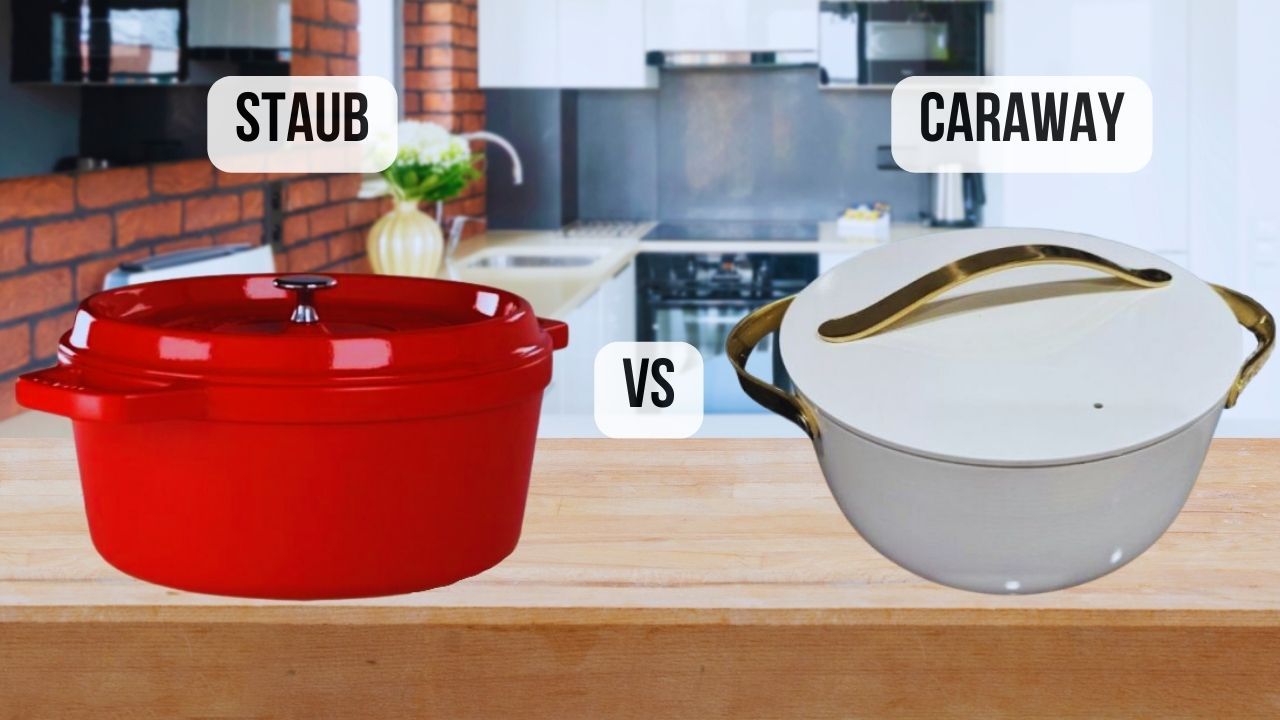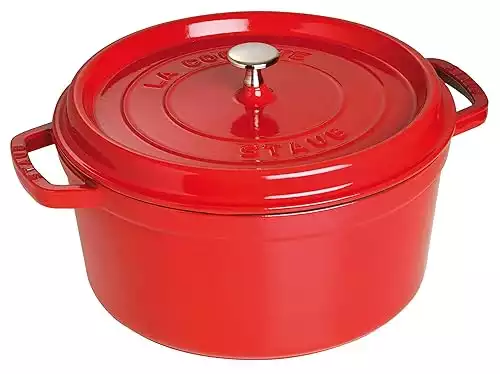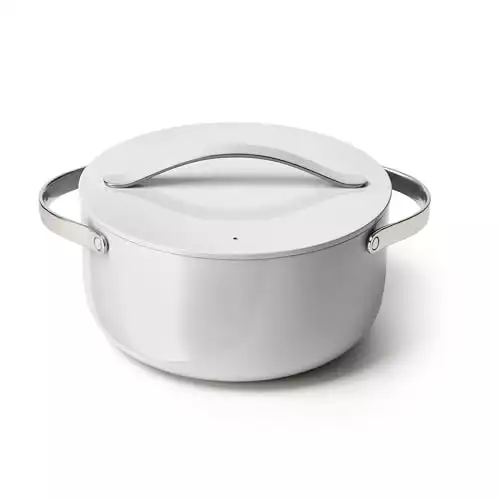Being a restaurant chef for a decade allowed me to work with different kitchen equipment and cookware. In this review, I’ll compare the Staub Dutch Oven and the Caraway Dutch oven, two popular Dutch oven options among home cooks and chefs.
This comparative review is based on the following crucial parameters:
- Material
- Weight
- Heat retention and compatibility
- Lid fit
- Handles and product design
- Colors
- Maintenance and cleaning
- Durability and performance
- Warranty
- Price
|
Our Rating:
4.8
|
Our Rating:
4.7
|
|
Pros:
|
Pros:
|
|
Cons:
|
Cons:
|
- Better material
- Better heat retention
- Tight-fitting lid
- Stylish and aesthetically pleasing design
- Easy to maintain
- Better durability and performance
- Lifetime warranty
- Heavier
- Ergonomic handles, but a bit narrow
- Not the most budget-friendly option
- Lighter
- Tightly fitting lid traps
- Cool handles and sleek design
- Easy to maintain and clean
- More reasonably priced
- Worse material
- Not holding heat as long as Staub
- Worse durability and performance
- One-year warranty
Staub is a popular premium cookware brand, often compared to Le Creuset. I purchased the Staub 5-quart Round Cocotte Dutch Oven and was excited to try it out.
The Caraway Dutch oven offers a modern and chic version of the traditional Dutch oven. Its sleek and contemporary appearance piqued my interest, so I bought one to test it.
These two particular Dutch ovens have made it into the TOP-5 ranking on the market.
Let us first look at these Dutch ovens and later find out how they differ and which is more suitable for your cooking needs.
In this review, I provide an independent assessment of the pros and cons of Staub and Caraway, based on my experience as a chef. If you choose to purchase it, please consider using the referral links included in this article. I earn a small commission from your purchases at no additional cost to you, which helps support this blog. Thank you!
Staub VS Caraway: Material
| Staub | Caraway |
|---|---|
| Staub Dutch Ovens are constructed from high-quality cast iron, which is renowned for its excellent heat retention and even heat distribution. The interior is coated with an enamel glaze that prevents rust and food from sticking. | Caraway Dutch Ovens are made from lightweight cast aluminum with a non-toxic ceramic nonstick layer. |
Staub VS Caraway: Weight
| Staub | Caraway |
|---|---|
| Staub Dutch Ovens tend to be on the heavier side due to their cast iron construction. While this weight is excellent for retaining heat, it might be a concern for those who prefer lightweight cookware. | Caraway Dutch Ovens are significantly lighter than their cast iron counterparts, making them more manageable for everyday cooking. |
Staub VS Caraway: Heat Retention and Compatibility
| Staub | Caraway |
|---|---|
| The Staub Dutch Oven excelled in heat retention. It maintains the temperature throughout the cooking process consistently. It is versatile and suitable for various cooking methods. It performed exceptionally well on both the stovetop and oven. | While Caraway Dutch Ovens perform well in heat retention, they may not hold heat as long as cast iron. They are compatible with various heat sources, including stovetops and ovens. |
Staub VS Caraway: Lid Fit
| Staub | Caraway |
|---|---|
| The tight-fitting lid in Staub Dutch Ovens ensures a snug seal, trapping moisture and flavor inside the pot, making it ideal for long-simmering dishes. | The Caraway Dutch Oven‘s tightly fitting lid traps moisture and preserves the flavor of the dishes I prepare. |
Staub VS Caraway: Handles and Product Design
| Staub | Caraway |
|---|---|
| The Staub Dutch Oven features ergonomic handles, although I find the space a bit narrow. It makes it slightly challenging to lift the pot, especially when wearing oven mitts.
Despite this handle design concern, the Dutch Oven’s overall product design is stylish and aesthetically pleasing. Its striking enameled exterior adds an elegant touch to the kitchen, making it a versatile piece suitable for cooking and serving. |
Caraway Dutch Ovens feature ergonomic stainless steel handles that stay cool on the stovetop. Their design is modern and sleek, fitting well in contemporary kitchens. |
Staub VS Caraway: Colors
| Staub | Caraway |
|---|---|
| Staub offers various elegant and vibrant colors to match your kitchen decor. | Caraway offers a limited but attractive color selection to match various kitchen aesthetics. |
Staub VS Caraway: Maintenance and Cleaning
| Staub | Caraway |
|---|---|
| Maintaining the Staub Dutch Oven is a breeze. The enamel interior is resistant to staining and remarkably easy to clean. After hours of slow-cooking the short ribs, I only needed a brief soak and a gentle scrub to have it looking as good as new. | It’s easy to maintain and clean the Caraway Dutch Oven. Even after lengthy cooking sessions, the nonstick ceramic coating makes cleaning up easy and helps avoid food sticking. It is also dishwasher safe, so you can save time cleaning it. |
Staub VS Caraway: Durability and Performance
| Staub | Caraway |
|---|---|
| Staub Dutch Ovens are renowned for their durability and performance. They can last a lifetime if well-maintained and are a chef’s favorite for slow-cooked stews and braises. | While Caraway Dutch Ovens may not match the lifelong durability of cast iron, they offer excellent performance and can serve you well for many years if maintained properly. |
Staub VS Caraway: Warranty
| Staub | Caraway |
|---|---|
| Staub provides a lifetime warranty with certain limitations for their cast iron cookware. This warranty addresses functional, material, and manufacturing defects found in cast iron cookware. | Caraway provides a one-year warranty, which is shorter than Staub’s, but still offers confidence in the product’s quality. |
Staub VS Caraway: Price
| Staub | Caraway |
|---|---|
| Staub Dutch Ovens are an investment with a price point that reflects their quality. They may not be the most budget-friendly option, but their longevity and performance make them worth it. | Compared to Staub, Caraway Dutch Ovens are more reasonably priced. Its price point makes it a desirable choice for people seeking quality without going over budget. |
Cooking Test
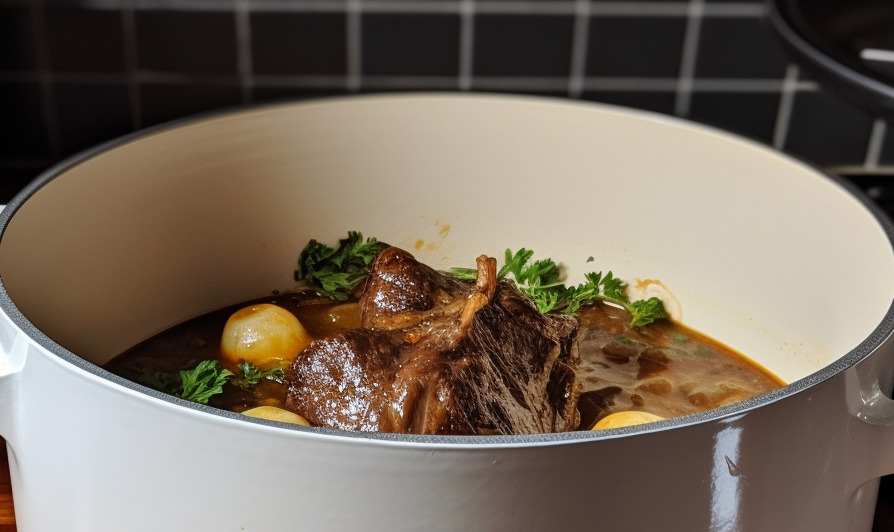
I conducted a cooking test using both the Staub Dutch Oven and the Caraway Dutch Oven to prepare a delectable dish of Red Wine Braised Short Ribs. During this culinary experiment, I evaluated various key parameters to provide a comprehensive comparison.
Browning
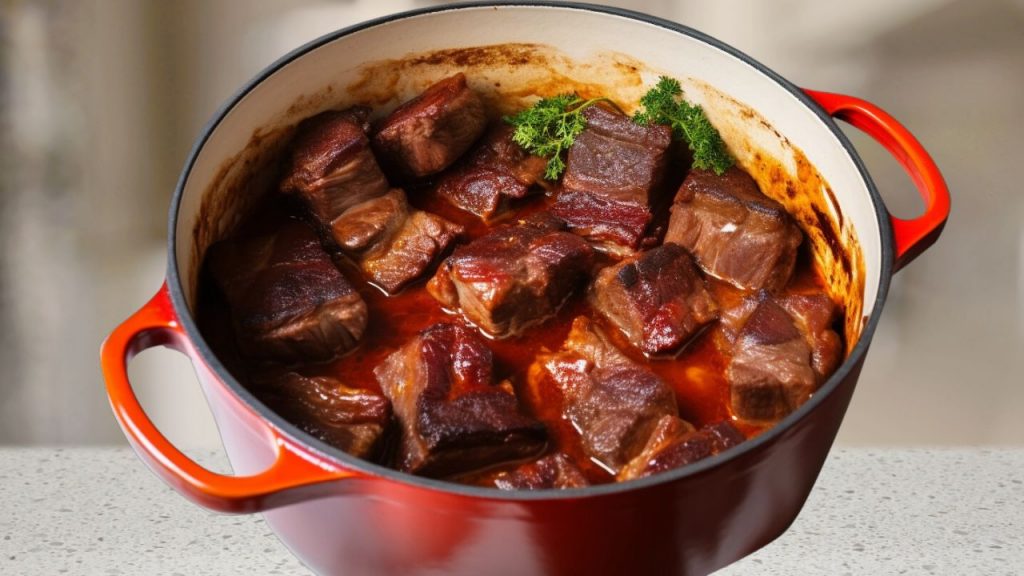
The initial step in the cooking process involved browning the short ribs. I carefully observed and compared the performance of both Dutch ovens to see how evenly and effectively they allowed the meat to sear. So far, both Dutch ovens have produced a beautiful sear on the ribs, enhancing the overall flavor and texture of the final dish.
Winner: Draw
Moisture Retention
Braising is all about preserving the moisture within the dish. I paid close attention to how well each Dutch oven retained moisture during the slow cooking process. Maintaining a consistent and moist environment is crucial for achieving succulent and tender short ribs.
In this category, the ribs from the Staub Dutch Oven stood out. The meat is more tender and juicer. The texture is also smooth and goes well with all the other ingredients.
Winner: Staub Dutch Oven
Final Flavor
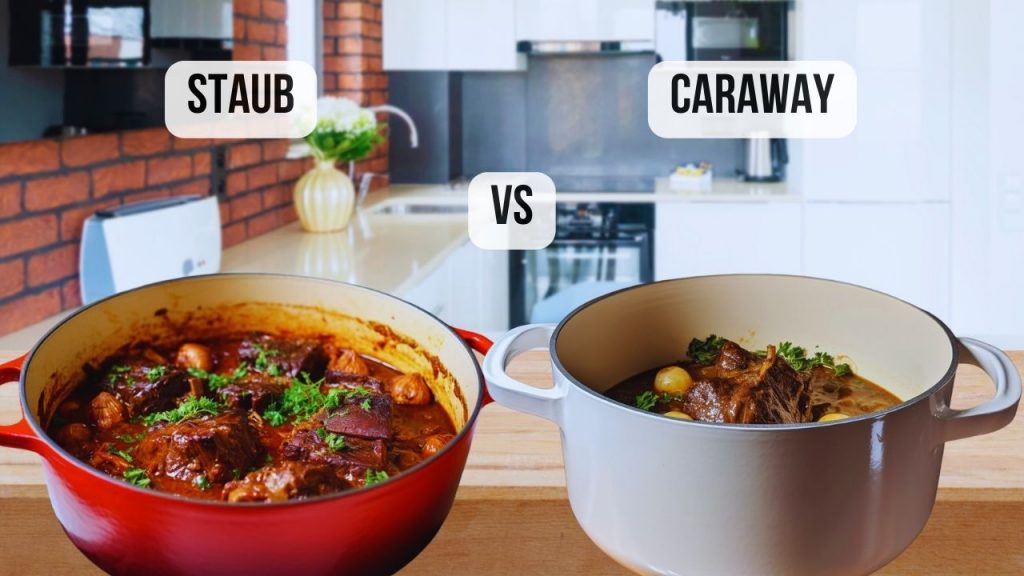
Ultimately, the most critical factor is the flavor of the Red Wine Braised Short Ribs. Both of the Dutch ovens created a rich and flavorful sauce. But during the tasting, I found Staub‘s creation more decadent and delectable.
Winner: Staub Dutch Oven
How We Tested
We prepared Red Wine Braised Short Ribs to test the Staub and Caraway Dutch Ovens. This dish is known for its complexity and demand for even heat distribution, moisture retention, and rich flavor development. Both Dutch ovens were used to prepare this dish to evaluate their performance under identical cooking conditions.
Throughout the cooking process, we closely observed and compared how each Dutch oven handled the various stages of cooking, from searing to braising. We noted any differences in performance, design, and functionality.
We want to give consumers a comprehensive and informative review of the Staub and the Caraway Dutch Ovens.
Conclusion: Staub is The Winner
|
Our Rating:
4.8
|
Our Rating:
4.7
|
|
Pros:
|
Pros:
|
|
Cons:
|
Cons:
|
- Better material
- Better heat retention
- Tight-fitting lid
- Stylish and aesthetically pleasing design
- Easy to maintain
- Better durability and performance
- Lifetime warranty
- Heavier
- Ergonomic handles, but a bit narrow
- Not the most budget-friendly option
- Lighter
- Tightly fitting lid traps
- Cool handles and sleek design
- Easy to maintain and clean
- More reasonably priced
- Worse material
- Not holding heat as long as Staub
- Worse durability and performance
- One-year warranty
The Staub Dutch Oven and Caraway Dutch Oven have strengths and qualities that make them suitable for various cooking needs.
Staub Dutch Oven excelled in heat retention and compatibility. Its tight-fitting lid and elegant design enhance its performance in slow-cooked dishes. It is easy to clean, and it comes with a lifetime warranty. However, it is heavier and comes at a higher price point.
Caraway’s Dutch Oven, made of lightweight cast aluminum with a nonstick ceramic coating, provides great heat distribution and is considerably lighter. It’s easy to maintain and clean, compatible with stovetops and ovens, and available at a more budget-friendly price. However, it may not retain heat as long as cast iron Dutch ovens and its warranty is limited to one year.
In a cooking test, both Dutch ovens performed admirably in browning the meat. However, the Staub Dutch Oven outshone in terms of moisture retention, resulting in more tender and juicier ribs. Furthermore, the final flavor was richer and more delectable than the Staub Dutch Oven.
As a chef, I recommend the Staub Dutch Oven for those seeking exceptional heat retention, superior durability, and a more exquisite flavor in their slow-cooked dishes. However, if budget considerations and ease of maintenance are your priorities, the Caraway Dutch Oven is a reasonable and efficient choice. Your choice ultimately depends on your cooking style, preferences, and budget.
However, if you are looking for an affordable Dutch oven for home cooking, then, Staub might be a good option for you. If you decide to purchase it, please use my referral link.

